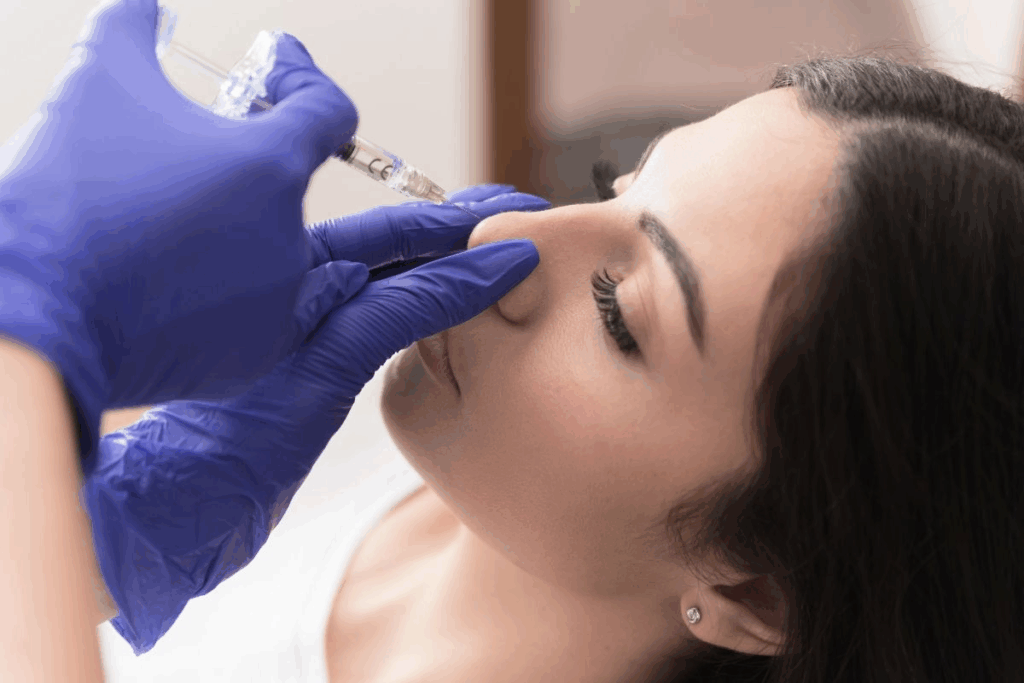
Getting insurance to cover septoplasty can be tough. But knowing what’s needed can help. Big insurers like Aetna will pay if it’s really needed. This is true if a deviated septum blocks your nose and other treatments don’t work. Can a deviated septum nose job (septorhinoplasty) be covered by insurance? Learn the requirements for medical necessity.
At Liv Hospital, we get how hard insurance can be. We want to help you understand how to get septoplasty covered. We’ll guide you through what you need and what to do next.

Septoplasty is a surgery to fix a deviated septum. It’s needed for those with nasal airway blockage. A deviated septum happens when the thin wall between the nasal passages is off-center. This causes breathing problems and other issues.
A deviated septum means the nasal septum is off-center. This makes one nasal passage smaller. It leads to breathing troubles, nosebleeds, and sinus infections.
Doctors say a deviated septum can come from genetics, injury, or developmental issues. The severity can vary. Some people have mild symptoms, while others face serious breathing problems.
People with a deviated septum often have symptoms like:
These symptoms can really affect a person’s life. They make simple tasks hard.
Septoplasty is needed when a deviated septum blocks the nasal airway a lot. Insurance like Aetna covers it when there’s proof of airway blockage and no help from other treatments.
“Septoplasty is considered medically necessary when septal deviation causes continuous nasal airway obstruction not responding to four or more weeks of appropriate medical therapy.”
Aetna Coverage Policy
Criteria | Description |
Documented Nasal Airway Obstruction | Evidence of significant nasal obstruction causing breathing difficulties |
Failed Conservative Treatment | Four or more weeks of medical therapy without significant improvement |
Secondary Conditions | Presence of sinusitis, epistaxis, or other related conditions |
Knowing these criteria helps people understand when they might need septoplasty. It’s important for getting insurance to cover the surgery.

Getting to know how insurance works for septoplasty starts with understanding the difference between reconstructive and cosmetic surgeries. This is key because insurance usually pays for reconstructive surgeries that fix health problems. Cosmetic surgeries, on the other hand, are often not covered.
Septoplasty can be for fixing health issues or for looks. Reconstructive septoplasty fixes a deviated septum to improve breathing and nasal function. Cosmetic rhinoplasty, though, is about making the nose look better. Insurance usually covers septoplasty if it’s needed to solve breathing problems or sinus issues.
Reconstructive septoplasty is often covered with the right medical proof. This includes test results and records of treatments that didn’t work. Cosmetic parts of the surgery are not usually covered. It’s important for patients to know this when talking to doctors about their options.
Insurance companies check if septoplasty is really needed. They look at medical proof from doctors, like:
They use this info to decide if septoplasty is needed for health reasons, not just for looks.
How much insurance covers septoplasty can change a lot between different providers. Coverage depends on the plan, but some patterns are seen:
Insurance Provider | Average Coverage Rate |
Aetna | 70-80% |
UnitedHealthcare | 60-75% |
Cigna | 65-80% |
These numbers are close but can change based on the plan, the patient’s health, and the doctor’s paperwork. It’s key for patients to check their policy and talk to their insurer to know what’s covered.
To get septoplasty insurance, patients must meet certain criteria. Big insurance companies like Aetna need detailed records to prove the need for a deviated septum nose job.
One key criterion is having a documented nasal airway obstruction. This happens when a deviated septum blocks airflow in the nose. Tests like nasal endoscopy or CT scans help confirm this.
It’s important for patients to see an ENT specialist for a full check-up. This shows how bad the obstruction is. This info is key for insurance approval.
Another criterion is trying and failing non-surgical treatments first. Insurance wants to see that other options were tried before septoplasty. These might include:
It’s important to show 4-6 weeks of trying these treatments consistently. This proves that other methods were not enough.
Having conditions like sinusitis and epistaxis can also help prove the need for septoplasty. Chronic sinusitis, for example, can lead to ongoing infections and problems.
We’ve made a table to summarize the main criteria and supporting conditions for septoplasty:
Criteria | Description | Typical Documentation Required |
Nasal Airway Obstruction | Significant impairment of nasal airflow | Nasal endoscopy, CT scan |
Failed Conservative Treatment | 4-6 weeks of non-surgical interventions | Medical records of treatments tried |
Secondary Conditions | Presence of sinusitis, epistaxis, or other related conditions | Medical history, diagnostic test results |
Understanding and documenting these criteria can help patients get insurance coverage. It’s vital to work with healthcare providers to gather all needed documents.
Knowing how to prepare for your medical consultation is key to getting septoplasty covered by insurance. A well-prepared patient can better navigate the process. This includes finding the right ENT specialist and ensuring all necessary documentation is ready.
Finding an ENT specialist with septoplasty experience is vital. Ask your primary care doctor for referrals or get suggestions from friends who have had the procedure. Also, check online reviews and verify the specialist’s credentials.
Look for an ENT specialist with a good track record in septoplasty. Their approach to patient care and communication skills matter. A board-certified specialist with a good reputation is likely to provide the care you need.
During your consultation, ask the right questions. This ensures you understand your diagnosis, treatment options, and what to expect. Some important questions include:
Documenting your symptoms before your appointment is helpful. Keep a symptom journal to track when symptoms occur and their severity. Note any factors that trigger or relieve them.
Make sure to record any nasal congestion, breathing difficulties, or sinus infections. This information will help your ENT specialist understand your condition and choose the best treatment.
Insurance plans for septoplasty vary among providers like Aetna, Medicare, and Medicaid. It’s key for patients to know these policies before the procedure.
Aetna covers septoplasty if certain criteria are met. Patients need to show significant nasal airway obstruction symptoms that haven’t improved with other treatments. Aetna asks for detailed records from doctors to prove the need for surgery.
Other big insurance companies have their own rules for septoplasty. Some might need more time of trying other treatments before surgery. It’s vital for patients to check their insurance policy and talk to their doctor about what’s needed.
Medicare and Medicaid also offer septoplasty coverage under specific conditions. Medicare covers it when it’s medically necessary, like for serious nasal blockage. Medicaid’s coverage varies by state, but most cover septoplasty when it’s needed.
Patients should talk to their doctor and insurance to get the details on septoplasty coverage.
Knowing the CPT codes for septoplasty is key for insurance coverage. CPT codes describe medical procedures and services. Using the right codes is vital for getting insurance to pay.
The main CPT code for septoplasty is 30520. It covers septoplasty or submucous resection, with or without cartilage work. This code is for fixing a deviated septum.
Here’s an example of how CPT code 30520 is used:
CPT Code | Description | Example Use |
30520 | Septoplasty or submucous resection | Surgical repair of a deviated septum |
For combined procedures, more CPT codes might be needed. For example, if a patient has both septoplasty and turbinate reduction, each procedure gets its own code.
Example of Additional CPT Codes:
Right CPT coding is key for insurance approval. Insurance uses these codes to check if a procedure is needed and to process claims. Wrong or mismatched codes can cause claims to be denied or delayed.
To make sure insurance claims go through, it’s important to:
To get insurance for septoplasty, you need to gather all your medical records. Insurance companies want to see your full medical history. They need to know why you need the surgery.
Diagnostic tests are key for your septoplasty claim. Nasal endoscopy and imaging studies like CT scans help show how a deviated septum blocks your airway. These tests show the problems in your nose that cause your symptoms.
“The use of nasal endoscopy allows for a detailed examination of the nasal passages, helping to identify any obstructions or abnormalities that may be contributing to the patient’s symptoms,” says Dr. John Smith, an ENT specialist.
Insurance needs proof that other treatments didn’t work before they cover septoplasty. You must keep a detailed record of your symptoms and treatments for at least four weeks. It’s important to work with your doctor to track your progress and any changes in your condition.
Opinions from specialists like otolaryngologists or ENTs can really help your claim. They can say if septoplasty is needed based on your situation. Their advice adds more proof that surgery is necessary.
With all your medical records, including tests, failed treatments, and specialist opinions, you can make a strong case for your septoplasty insurance claim.
Getting septoplasty covered by insurance starts with pre-authorization. This step can be tricky but doable with the right help. We’ll guide you through the key steps to get your septoplasty approved by your insurance.
The first step is to submit your initial request. You’ll need to collect all important documents. This includes your doctor’s diagnosis, past treatments, and test results. Make sure your healthcare provider sends a detailed and well-documented request to your insurance.
Key components of the initial request include:
A well-prepared initial submission can help avoid delays or denials.
After you send in your request, your insurance might ask for more info. It’s important to answer these questions quickly. Your healthcare provider’s office should be ready to address any insurance concerns.
“Effective communication between the patient’s healthcare provider and the insurance company is key to a successful pre-authorization process.” –
Expert Opinion
After you submit your request, keep an eye on its status. Regularly check in with your healthcare provider and insurance company. Knowing the timeline helps manage your expectations and ensures approval on time.
Step | Timeline | Responsible Party |
Initial Submission | 1-3 days | Healthcare Provider |
Insurance Review | 7-14 days | Insurance Company |
Responding to Inquiries | As needed | Healthcare Provider/Patient |
Authorization Decision | Variable | Insurance Company |
By following these steps and keeping good communication with your healthcare provider and insurance, you can smoothly go through the pre-authorization process.
Understanding insurance for septorhinoplasty is key. It’s about knowing the difference between what’s covered and what’s not. This procedure fixes both how you breathe and how you look, making it tricky for insurance.
Septorhinoplasty mixes fixes for breathing and looks. To get insurance, you must prove the breathing part is needed. Insurance usually pays for things that fix real health problems, like a blocked nose.
Key Considerations:
Septorhinoplasty’s cost is split between what’s covered and what’s not. You need to show what’s medically necessary. This means working with your insurance to make sure they cover the right parts.
Procedure Component | Insurance Coverage | Cost Allocation Responsibility |
Functional (e.g., correcting deviated septum) | Typically Covered | Insurance Provider |
Cosmetic (e.g., aesthetic rhinoplasty) | Not Covered | Patient |
Combined Functional and Cosmetic | Partially Covered | Shared between Insurance Provider and Patient |
To get insurance for septorhinoplasty’s breathing fixes, you need special papers. This includes medical records and test results. You might also need a letter from your doctor explaining why you need the surgery.
Knowing how insurance works for septorhinoplasty helps. With the right papers, you can make sure you get the coverage you deserve for the breathing fixes.
Insurance denials for septoplasty are common. Knowing how to appeal is key. When denied, understanding the reasons is vital to challenge it effectively.
Insurance companies deny septoplasty for several reasons. These include:
The appeals process has several steps. Follow them carefully:
Being thorough and persistent is key during the appeals process.
Appeals Process Step | Action Required | Timeline |
1. Review Denial Letter | Understand reasons for denial | Within 1 week |
2. Gather Documentation | Collect additional evidence | Within 2 weeks |
3. Submit Formal Appeal | Send appeal letter and documentation | Within 30 days |
If your appeal is denied, you can seek an external review. This is an independent review of your case. It’s important if you think your claim was unfairly denied.
“An external review can provide an unbiased assessment of your case, potentially overturning the insurance company’s decision.”
— Medical Advocacy Group
External review can be a strong step to get the coverage you need for septoplasty.
Getting insurance to cover septoplasty can be tricky. But, knowing how it works is key to a good outcome. By following the steps in this article, patients can get their deviated septum nose job covered.
We talked about what septoplasty and deviated septum are. We also covered the basics of insurance and what’s needed for septoplasty to be covered. Plus, we gave a guide on how to get pre-authorization and what to do if insurance says no.
It’s important to work with your ENT specialist and insurance company. This way, patients can make sure their septoplasty is covered. This makes the procedure easier to get and more affordable.
Understanding septoplasty insurance and knowing how to deal with insurance can help. It’s the first step to fixing deviated septum issues and improving life quality.
Septoplasty is a surgery to fix a deviated septum. This is when the wall between the nostrils is off-center. It can make breathing hard and cause other breathing problems.
Yes, insurance often covers septoplasty. This is if it’s needed to fix a deviated septum that’s causing big health problems.
To get insurance for septoplasty, you need to show that you can’t breathe well through your nose. You also need to have tried other treatments first.
Insurance companies check if septoplasty is needed. They look at your symptoms, treatment history, and test results.
Reconstructive septoplasty fixes breathing problems. Cosmetic septoplasty is for looks and isn’t usually covered by insurance.
Yes, Aetna covers septoplasty if it’s medically necessary. They have specific rules for coverage.
The CPT code for septoplasty is 30520.
To get ready for a consultation, find a good ENT doctor. Write down your symptoms. Be ready to talk about your health and treatment options.
You’ll need test results, proof that other treatments didn’t work, and a specialist’s opinion.
To get through the pre-authorization process, start by asking for approval. Answer any questions from your insurance. Keep track of your approval status.
If your claim is denied, you can appeal. You’ll need to provide more information and evidence to support your case.
Using the right code, like CPT 30520, is key. It shows the procedure is covered by insurance.
Septorhinoplasty is a mix of septoplasty and rhinoplasty. Insurance coverage depends on if it’s for health reasons or just for looks.
Subscribe to our e-newsletter to stay informed about the latest innovations in the world of health and exclusive offers!
WhatsApp us